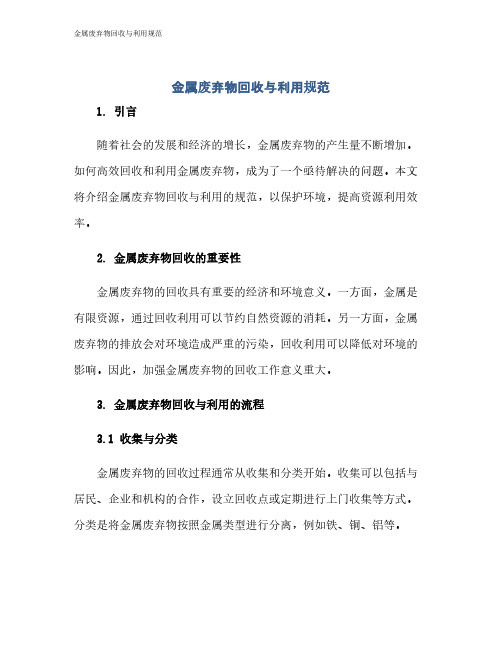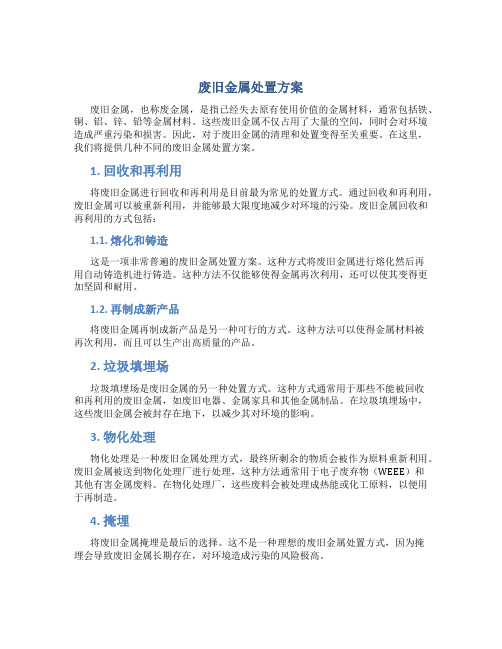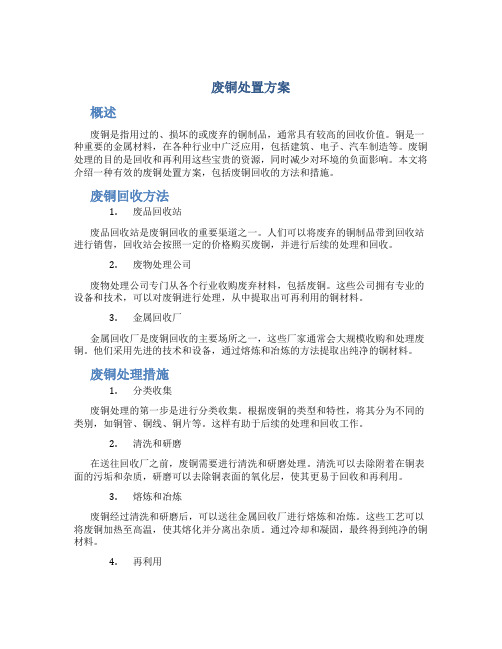金属废物回收利用方法
废铁回收利用方法

废铁回收利用方法废铁回收利用方法废铁是指失去使用价值的铁制品或铁制废弃物,废铁回收利用是指通过一系列的工艺和技术,将废铁重新加工利用,使其再次成为有价值的铁制品。
废铁回收利用具有环保、节能、资源化等众多优点,对于推动循环经济、减少资源浪费具有重要意义。
下面将介绍一些常见的废铁回收利用方法。
第一种方法是废铁熔炼回收利用。
废铁熔炼是将废铁经过高温熔化,然后进行调质处理,最后得到各种合金材料的技术过程。
通过废铁熔炼,可以获得高质量的再生铁、精炼铁和合金铁,这些再生铁可以进一步加工成各种形状的铁制品,如钢板、钢管、钢筋等。
废铁熔炼回收利用方法具有高效、节能的特点,可以大大降低废铁的处理成本,同时还可以减少新铁矿石的开采和炼制,从而减少对环境的破坏。
第二种方法是废铁加工回收利用。
废铁加工是指对废铁进行切割、压扁、破碎等加工处理,将其弄碎成粒状或片状,然后再进行后续的再利用或再加工。
废铁加工回收利用方法主要包括废铁造粒、废铁压块和废铁打包等。
废铁造粒是将废铁碎片经过特殊的粉碎机械处理,将其压缩成颗粒状或球状,然后用作冶金炼铁的原料;废铁压块是将废铁碎片通过压块机压缩成块状,然后用于再加工成不同形状的铁制品;废铁打包是将废铁碎片通过打包机进行压缩封装,然后再进行运输和销售。
废铁加工回收利用方法可以使废铁占用的空间减小,方便储存和运输,同时也可以提高废铁的再利用率,减少资源的浪费。
第三种方法是废铁零拆回收利用。
废铁零拆是指将废铁制品进行细致分解,将其中的有用部分分离出来,然后再进行重新加工利用。
废铁零拆回收利用方法主要包括废铁拆解、废铁分类和废铁加工三个步骤。
废铁拆解是将废铁制品进行拆解和拆卸,分离出其中的铁质材料,同时还可以回收其他有价值的金属材料;废铁分类是根据废铁的不同性质和用途,将其进行分类,以便更好地进行后续的加工利用;废铁加工是将废铁进行进一步的加工处理,例如去除污染物、脱脂、表面处理等,然后再进行再利用。
金属废弃物资源综合利用案例分析

金属废弃物资源综合利用案例分析随着全球经济的快速发展和工业化进程的加速推进,金属废弃物的处理和利用问题日益突出。
为了解决资源浪费和环境污染的问题,金属废弃物的综合利用成为以可持续发展为目标的重要课题之一。
本文将通过案例分析,探讨金属废弃物资源综合利用的可行性和效益。
案例一:废旧电池回收与再利用废旧电池由于含有有害物质,成为了环境和健康的隐患。
但废旧电池中包含的金属物质,如锌、镍、镉等具有重要的再利用价值。
中国某电池生产企业在面临废旧电池处理问题时,采取了综合利用的策略。
首先,利用先进的回收技术,对废旧电池进行分解和分离,再提取出其中的有价金属。
随后,对提取出的金属进行精细处理和加工,以生产新的电池产品。
通过这种方式,废旧电池得到了高效回收与再利用,不仅降低了环境污染风险,还节约了矿石资源的开采。
案例二:废旧金属回收与循环利用废旧金属是另一个重要的金属废弃物资源。
在某国家的城市中心地区,废旧金属的大规模堆积已经成为了当地空间利用的难题。
为了有效解决这一问题,政府与企业合作,建立了一个废旧金属回收与循环利用的系统。
市民可以将废旧金属送至指定的回收点,然后由专业的团队进行分类、拆解和再加工。
通过高效的循环利用技术,废旧金属被转化为新的产品,如建筑材料、家电等。
这不仅减少了废旧金属对环境的负面影响,还创造了就业机会和经济效益。
案例三:冶炼废渣资源化利用在冶金产业中,生产过程中所产生的废渣经常成为了环境污染的源头。
某国钢铁企业为了解决冶炼废渣的处理问题,引入了资源化利用技术。
通过综合利用的方法,这家企业将废渣转化为铁基材料、矿山充填等新产品。
利用这些废渣资源化利用技术,不仅降低了环境污染风险,还有效节约了能源和原材料的消耗。
总结:通过对以上金属废弃物资源综合利用案例的分析,可见金属废弃物的综合利用对于实现资源的可持续利用和保护环境具有重要意义。
在金属废弃物的回收与再利用过程中,科学技术的应用是关键。
政府、企业和公众都应加强合作,共同推动金属废弃物资源综合利用的发展和完善。
金属冶炼中的废弃物处理与回收利用

03
金属冶炼废弃物回收利用
有价金属的回收利用
有价金属回收
在金属冶炼过程中,会产生大量废弃物,其中含有许多有价值的金属元素,如铜、铁、锌、铅等。通过有效的回 收技术,可以将这些有价金属从废弃物中分离出来,进行再利用。
资源化利用
通过金属冶炼废弃物的资源化利用,实现废弃物 的再利用,降低资源消耗和环境污染。
3
智能化监控与管理
利用物联网、大数据等技术手段,实现金属冶炼 废弃物的智能化监控和管理,提高处理效果和效 率。
政策法规与标准
01 02
政策支持
政府应加大对金属冶炼废弃物处理与回收利用的政策支持力度,制定相 关税收优惠、资金扶持等政策,鼓励企业开展废弃物处理与回收利用工 作。
法规监管
完善相关法律法规,加强对金属冶炼废弃物处理与回收利用的监管力度 ,规范企业行为,防止二次污染。
03
标准制定
制定严格的金属冶炼废弃物处理与回收利用标准,提高企业准入门槛,
推动行业整体水平的提升。
05
实际案例分析
某钢铁企业废弃物处理与回收利用实践
废弃物来源与分类
该钢铁企业产生的废弃物主要包括炉渣、尘泥、含铁尘等,根据 不同来源和性质进行分类处理。
安全风险
金属冶炼废弃物的不规范处理和处 置,可能引发安全事故,对人们的 生命财产安全造成威胁。
金属冶炼废弃物处理的重要性
01
02
03
环境保护
通过有效的金属冶炼废弃 物处理,可以减少对环境 的污染,保护生态环境。
资源利用
对金属冶炼废弃物进行回 收利用,可以充分利用资 源,减少资源浪费。
安全保障
规范处理和处置金属冶炼 废弃物,可以降低安全风 险,保障人们的生命财产 安全。
废金属废物利用说明

废金属废物利用说明
废金属废物利用是指对废弃金属进行回收、再加工,以获得新的金属产品或其他有价值的材料。
废金属废物通常包括废弃的金属制品、废旧汽车、废旧电器和电子产品等。
废金属废物利用有以下几个主要的步骤:
1. 收集:废金属废物必须首先进行收集。
可以通过设立回收站点、委托回收公司或者政府组织进行收集。
人们可以将废金属废物分类存放,比如铁、钢、铝等,以便后续处理。
2. 分拣和处理:废金属废物收集后需要进行分拣和处理。
常见的分拣方式包括手工分拣和机械分拣。
分拣完成后,对不同种类的废金属进行处理,包括清洁、破碎或者压缩等,以便后续加工利用。
3. 冶炼和提炼:经过处理的废金属废物可以进行冶炼和提炼,以获得纯净的金属材料。
不同种类的废金属可能需要不同的冶炼和提炼过程,比如高温冶炼、溶解、电解等。
4. 再加工:通过冶炼和提炼得到的纯净金属可以再次被加工和利用。
再加工可以包括铸造、热处理、轧制、锻造等工艺,以获得新的金属制品。
废金属可以被加工成为钢材、铝材、铜材等,用于生产汽车零部件、建筑材料、家具、容器等。
废金属废物的利用有助于环境保护和资源回收利用。
它可以减少对原生金属资源的开采需求,降低能源消耗和环境污染,同
时也节约了金属材料的成本。
废金属利用还可以创造就业机会,促进经济发展。
在废金属废物利用中,需要注意的是要采用科学的处理方法,确保废物处理过程不会对环境和人们的健康造成负面影响。
政府和相关机构应加强监管,制定相关规章制度以规范废金属废物的收集、处理和利用。
同时,公众也应增强环保意识,积极参与到废金属废物的回收利用中。
金属冶炼中的废物处理与资源回收

汇报人:
CONTENTS
PART ONE
PART TWO
废物分类:根据金属种类、化学性质、物理状态等进行分类 物理处理方法:如磁选、浮选、重力分离等 化学处理方法:如酸浸、碱浸、氧化还原等 生物处理方法:如微生物降解、生物吸附等 热处理方法:如焚烧、热解等 综合处理方法:结合多种处理方法,实现废物的资源化利用
技术应用:采用先 进的冶炼技术,如 电弧炉、转炉等
示范工程:建设示 范工程,如废旧金 属回收利用示范基 地
技术特点:高效、 节能、环保
实践经验:通过实 践经验,不断优化 技术应用和示范工 程
采用先进的废物处 理技术,提高资源 回收率
加强废物处理与资 源回收的监管,确 保环保达标
建立完善的废物处 理与资源回收体系 ,提高效率
政策支持:政府 对废物处理与资 源回收产业的扶 持政策
标准制定:制定 相关标准和规范, 确保废物处理与 资源回收的规范 化和标准化
技术研发:鼓励 企业加大技术研 发投入,提高废 物处理与资源回 收的技术水平
市场机制:建立 完善的市场机制, 促进废物处理与 资源回收产业的 健康发展
企业社会责任:关注环境保护,承担社会责任 环保意识:提高员工环保意识,加强环保教育 废物处理技术:研发和应用先进的废物处理技术 资源回收利用:提高资源回收利用率,减少废物产生
离
优点:效率高, 可处理大量金
属废物
缺点:能耗高, 对设备要求高
应用:广泛应 用于钢铁、有 色金属等行业
原理:利用化学溶剂溶解金属,实 现金属与非金属的分离
应用:广泛应用于铜、锌、镍、钴 等金属的回收
添加标题
添加标题
添加标题
添加标题
优点:可处理低品位、复杂成分的 矿石,回收率高
钢铁废弃物如何得到合理处理和利用

钢铁废弃物如何得到合理处理和利用在现代工业的快速发展中,钢铁生产占据着至关重要的地位。
然而,伴随着钢铁生产过程,不可避免地会产生大量的废弃物。
这些钢铁废弃物如果得不到合理的处理和利用,不仅会对环境造成巨大的压力,也是对资源的一种严重浪费。
那么,如何让这些钢铁废弃物“变废为宝”,实现合理的处理和利用呢?钢铁废弃物的种类繁多,常见的有废渣、废水、废气以及废旧钢铁制品等。
废渣包括炼铁渣、炼钢渣等;废水主要来自冷却、洗涤等环节,含有各种有害物质;废气则包含二氧化硫、氮氧化物等污染物;废旧钢铁制品则是指报废的机器设备、建筑钢材等。
对于废渣的处理和利用,有着多种可行的方法。
一方面,可以将废渣用于建筑材料的生产。
例如,炼铁渣经过处理后,可以制成矿渣水泥,其具有良好的抗压强度和耐久性。
炼钢渣则可以用于道路铺设,提高道路的稳定性和承载能力。
另一方面,废渣中的一些金属元素还可以通过回收技术进行提取,实现资源的再利用。
废水的处理至关重要。
首先,需要通过物理、化学和生物等方法对废水进行净化处理,去除其中的有害物质,如重金属离子、有机物等。
经过处理后的废水,可以在钢铁生产过程中进行循环使用,从而减少新水的取用,降低水资源的消耗。
同时,也可以将处理后的达标废水用于城市绿化、工业冷却等方面。
废气的处理则需要依靠先进的净化设备和技术。
常见的方法有脱硫、脱硝和除尘等。
通过安装脱硫装置,可以将废气中的二氧化硫转化为硫酸等有用物质;脱硝技术则能减少氮氧化物的排放;而高效的除尘设备能够去除废气中的颗粒物,降低大气污染。
废旧钢铁制品的回收利用是钢铁废弃物处理的重要环节。
这些废旧钢铁可以通过回炉重熔的方式,重新制成新的钢铁产品。
与从铁矿石炼制钢铁相比,回收利用废旧钢铁能够大大降低能源消耗和二氧化碳排放,同时也减少了对矿产资源的开采。
要实现钢铁废弃物的合理处理和利用,离不开先进的技术和设备支持。
目前,许多钢铁企业都在不断加大研发投入,探索新的处理和利用技术。
金属冶炼废物的处理和资源化利用措施

环保法规和标准日益严格,对金属冶炼废物处理和资源化利用提出了更高的要求。
环保法规和标准日益严格,对金属冶炼废物处理和资源化利用的技术、设备和工艺提出 了更高的要求。
环保法规和标准日益严格,对金属冶炼废物处理和资源化利用的成本和效益提出了更高 的要求。
环保法规和标准日益严格,对金属冶炼废物处理和资源化利用的监管和执法提出了更高 的要求。
经济效益:金属冶炼废物处理和资源化利用需要投入大量资金和技术,需要平衡经济效益和 社会效益
社会效益:金属冶炼废物处理和资源化利用可以减少环境污染,提高资源利用率,需要平衡 经济效益和社会效益
技术挑战:金属冶炼废物处理和资源化利用需要先进的技术和设备,需要平衡经济效益和社 会效益
政策支持:金属冶炼废物处理和资源化利用需要政府政策的支持和引导,需要平衡经济效益 和社会效益
PART FIVE
研发新型冶炼技术, 提高资源利用率
开发高效环保的冶 炼设备,降低污染 排放
探索金属废物的循 环利用,实现资源 化利用
加强国际合作,共 享技术成果,推动 行业发展
资金投策支持:政府出台相关政策, 鼓励企业进行金属冶炼废物处 理和资源化利用
利用金属冶炼废 物中的金属元素, 如铁、铜、锌等, 制作催化剂或载 体材料
通过化学反应, 将金属冶炼废物 中的金属元素转 化为催化剂或载 体材料
利用金属冶炼废 物中的非金属元 素,如硅、铝、 钙等,制作催化 剂或载体材料
通过物理或化学 方法,将金属冶 炼废物中的非金 属元素转化为催 化剂或载体材料
利用废铜渣制备路面材料
添加标题
添加标题
利用废铝渣制备墙体材料
添加标题
添加标题
利用废铅渣制备建筑装饰材料
钢铁屑的处理方式

钢铁屑的处理方式钢铁屑是指在钢铁加工过程中产生的废弃物,由于其具有较高的金属含量,因此需要进行专门的处理,以便回收利用或安全处置。
下面将介绍几种常见的钢铁屑处理方式。
1. 回收利用钢铁屑可以通过一系列的处理步骤,将其中的金属成分提取出来,然后进行回炉再造或者重新加工成新的钢材。
首先,钢铁屑需要经过清洗和分类,去除杂质和其他非金属物质。
接下来,可以采用熔炼、冶炼等方法,将钢铁屑中的金属熔化,然后进行分离和纯化,最终得到高品质的钢材。
2. 粉碎再利用钢铁屑可以经过粉碎处理后再利用。
首先,将钢铁屑进行机械粉碎,使其变成小颗粒或粉末状。
然后,可以将粉碎后的钢铁屑用于制造铁粉、铁合金等产品。
这种处理方式不仅能够有效地利用钢铁屑,还可以减少对原材料的需求,降低成本。
3. 压块回收钢铁屑可以通过压块机进行压缩,制成块状物,方便储存和运输。
压块回收是一种比较简单和常见的处理方式。
将钢铁屑放入压块机中,经过高压的作用,钢铁屑被紧密压缩成块状。
这些压块可以直接用于冶炼、炼钢等过程中,也可以作为原料进行再加工。
4. 焚烧处理对于无法直接回收利用的钢铁屑,可以进行焚烧处理。
焚烧可以将钢铁屑燃烧成灰渣,然后进行处理和处置。
在焚烧过程中,需要控制燃烧温度和保持良好的燃烧氧化条件,以确保钢铁屑完全燃烧,减少有害物质的排放。
焚烧处理可以有效地减少钢铁屑的体积,降低对环境的影响。
5. 埋填填埋对于无法回收利用或焚烧处理的钢铁屑,可以采用埋填填埋的方式进行处理。
将钢铁屑埋入地下,然后进行覆盖,使其与周围环境隔离。
埋填处理需要选择合适的场地,以避免对地下水和土壤等环境造成污染。
此外,还需要监测和管理埋填场,确保钢铁屑的安全处置。
钢铁屑的处理方式多种多样,根据实际情况选择合适的处理方法非常重要。
回收利用、粉碎再利用、压块回收、焚烧处理和埋填填埋等方式可以根据钢铁屑的性质和用途进行选择。
无论采用哪种处理方式,都需要注意环保和安全,确保钢铁屑的合理处置,实现资源的最大化利用。
金属废料的危险废物回收与处理方法

金属废料的危险废物回收与处理方法介绍金属废料是指废弃的金属制品或金属制品的残余,包括铁、铜、铝、锌等金属。
随着工业化的发展,金属废料的产生量不断增加,如何回收和处理金属废料成为一个重要的问题。
金属废料在处理过程中可能含有危险或有害物质,如重金属、化学品或放射性物质,这些物质对环境和人体健康带来潜在的危害。
因此,金属废料的回收与处理方法需要科学和有效,以确保对环境和人体的保护。
回收方法1. 分类回收金属废料的分类回收是通过将金属废料根据不同的金属种类进行分类和分离,以便进一步进行回收。
常见的分类回收方法包括手工分拣和机械分拣。
手工分拣是在人工操作下进行的,适用于小规模的金属废料回收场所机械分拣则是利用先进的分选设备进行金属废料的自动化分类,适用于大规模的金属废料回收厂。
2. 熔炼回收金属废料的熔炼回收是将金属废料加热至高温并使其熔化,使金属分离出来,以便进一步提炼和利用。
熔炼回收常用的方法包括高炉法、电炉法和气相冶金法。
高炉法是将金属废料与焦炭在高温条件下进行反应,使金属分离出来电炉法则是通过电炉加热将金属废料熔化,并通过电解过程使金属分离出来气相冶金法则是使用气体将金属废料加热至高温,并通过气氛中的化学反应将金属分离出来。
3. 化学回收金属废料的化学回收是利用化学反应使金属从废物中析出或溶解,并在后续步骤中进行提纯和回收。
化学回收方法依赖于金属废料的化学性质,常见的化学回收方法包括浸出法、沉淀法、萃取法和电解法。
浸出法是通过溶剂将金属从废料中溶出沉淀法则是通过化学反应使金属从废料中析出萃取法是利用有机溶剂将金属从废料中提取出来电解法则是通过电解过程将金属从废料中电解出来。
处理方法1. 固废处理金属废料中可能含有有害物质,如重金属或化学品,这些物质对环境和人体健康具有潜在的危害。
因此,金属废料的固废处理是确保废料中有害物质不对环境造成污染的重要环节。
常见的固废处理方法包括焚烧、填埋和物理化学处理。
金属冶炼中的废弃物处理与资源回收利用

废弃物中有价元素的循环利用
闭路循环
01
将废弃物中的有价元素循环回生产流程中,减少对外部资源的
依赖。
开路循环
02
将废弃物中的有价元素回收后用于其他用途,不直接循环回生
产流程。
联合循环
03
结合闭路循环和开路循环,实现有价元素的综合利用。
金属冶炼废弃物处
04
理与资源回收利用
的挑战与前景
当前面临的挑战
实际案例分析
05
某钢铁企业废弃物处理与资源回收利用案例
废弃物来源
处理方法
钢铁企业在生产过程中产生的废渣、废气 、废水等废弃物。
采用高温熔炼、化学沉淀、吸附等方法对 废弃物进行无害化处理,同时回收利用废 弃物中的有价元素。
资源回收利用
案例效果
将处理后的废弃物中的铁、锰、锌等有价 元素进行分离和提纯,再利用于生产过程 ,实现资源的循环利用。
湿法冶金
利用化学反应,从废弃物中提取有价 金属。
废弃物无害化处理技术
固化/稳定化
将有害废弃物转化为不易溶解、 无害化的固体形态。
焚烧处理
将废弃物在高温下燃烧,分解有 害物质。
电解处理
通过电解方法,将有害物质转化 为无害物质。
金属冶炼废弃物资
03
源回收利用
废弃物中有价金属的提取与分离
火法冶金
通过高温熔炼,使金属与其他杂质分离,适用于 大规模处理。
金属冶炼中的废弃物处 理与资源回收利用
汇报人:可编辑 2024-01-06
目 录
• 金属冶炼废弃物概述 • 金属冶炼废弃物处理技术 • 金属冶炼废弃物资源回收利用 • 金属冶炼废弃物处理与资源回收利用的挑战与
前景 • 实际案例分析
废旧金属再生利用技术研究

废旧金属再生利用技术研究一、背景介绍随着现代工业的发展,废旧金属的产生量越来越大,这不仅给环境带来了危害,同时也造成了资源的浪费。
针对这一问题,各国都开始研究废旧金属的再生利用技术,以实现废物转宝贵资源的目标。
二、废旧金属再生利用技术概述废旧金属再生利用技术主要包括熔炼法、物理处理法、化学处理法等多种技术。
其中,熔炼法是最常用的技术。
其基本操作流程是将废旧金属加热至熔点,然后进行分离、净化和合金化等操作,最终得到高纯度的金属原料。
物理处理法包括机械剪切、压缩、破碎等方法,通过加工将废旧金属分割成小块,使其便于储存、运输和加工。
化学处理法则主要利用化学反应将废旧金属中有毒有害的成分转化为无害物质,如利用电解法将锌电镀料还原回锌等。
三、各类废旧金属再生利用技术细节1. 熔炼法熔炼法是针对铜、铝、锡、铅、锌等无机金属的技术。
在具体操作过程中,需要根据材料的不同,分别选择适合的熔炼炉和熔炼方法。
例如,铜材料可以选择电炉、火炉、转炉或氧化焙烧炉等炉型。
2. 物理处理法机械剪切是将废旧金属分割成小块的常用方法之一,这需要选用专业的机器设备。
在具体操作过程中需要注意安全,避免剪切过程中产生限位、逆压等问题。
3. 化学处理法化学处理法主要包括酸洗、电渣重熔、电镀、电解和还原等方法。
其中,电镀以及电解法是常用的化学处理方法之一,它们广泛应用于废旧金属的处理领域。
在具体操作中,需要注意废物的颜色、类型以及配比等因素,以确保处理过程的高效性和资金利用率。
四、废旧金属再生利用技术的应用前景废旧金属的再生利用技术已经成为各个国家资源回收和环保的重要工作之一,由此也催生了废旧金属再生利用产业的发展。
尽管在技术和生产中还面临一些技术难题,如高温和高压环境下的废物处理和深度分离技术等,但是由于其对保护环境和节约资源的重要作用,废旧金属再生利用技术的应用前景是非常广阔的。
五、结论综上所述,废旧金属再生利用技术包括熔炼法、物理处理法、化学处理法等多种方法,在技术和生产中还面临一些技术难题,但是未来仍有广阔的应用前景。
举例说明生产和生活中金属垃圾再利用的方法

举例说明生产和生活中金属垃圾再利用的方法在咱们的日常生活中,金属垃圾就像是一位被冷落的老朋友,虽然它看上去不起眼,但其实潜藏着巨大的价值。
你可别小瞧这些废弃的金属,今天我就来跟大家聊聊如何把这些“金属垃圾”变成宝贝,既能保护环境,又能省下不少银子,真是一举两得呢!1. 家庭中的金属再利用1.1 自家旧物改造你有没有发现,家里的旧家具、旧电器一堆堆地堆在角落,仿佛在跟你诉苦?比如说,旧的锅碗瓢盆,这些金属制品不一定要扔掉。
其实,我们可以把它们改造成花盆。
只需在旧锅底部打几个小孔,便能排水,再放上土壤和植物,一盆绿色的“小家伙”立马就能让家里生机勃勃。
说不定,你的家居风格还能瞬间提升,成了朋友们争相模仿的对象呢!1.2 利用金属罐还有那些用完的金属罐,比如啤酒罐和食物罐。
别再扔掉它们!我们可以把罐子清洗干净,然后给它们涂上颜料,变身为五彩缤纷的笔筒或储物罐,简直是家里的“颜值担当”。
想象一下,客厅桌上摆着一排颜色各异的笔筒,随便拿一支笔,写起字来都带劲儿,心情也会随之大好!2. 工业中的金属再利用2.1 废料回收在生产过程中,企业通常会产生一些金属废料。
许多企业已经意识到这其中的商机,纷纷开展金属回收。
比如,汽车制造厂在生产汽车时,会有很多金属边角料。
这些废料可以被回收利用,熔炼成新钢材,重新进入生产链条,减少资源浪费。
简而言之,就是把“废物”变成“宝物”,省钱又环保,一举两得,何乐而不为呢?2.2 创新设计而且,现在有些设计师真的是脑洞大开!他们利用废弃的金属材料,创造出一系列精美的艺术品,比如金属雕塑、装置艺术等。
这些作品不仅美观,还传达了环保的理念,告诉人们珍惜资源的重要性。
想想看,原本该被丢弃的金属,经过巧手的加工,竟然成了艺术品,这真是让人叹为观止呀!3. 社区与公益活动3.1 组织回收活动在我们的社区,很多地方也开始重视金属垃圾的再利用。
比如,社区组织了一些“金属回收日”,大家可以把家里不再需要的金属物品带到指定地点,交给专门的回收公司。
快速回收金属的方法有哪些

快速回收金属的方法有哪些快速回收金属的方法有很多,主要包括物理方法和化学方法。
下面我将详细介绍其中一些常见的方法。
1. 废金属分类:首先,要将废金属进行分类。
根据金属的种类和质量,将其分为不同的类别,以便进行后续处理。
2. 磁选法:对于具有磁性的金属,可以使用磁选法进行回收。
这种方法通过使用磁性分离器,将磁性金属从废物中分离出来,以实现金属的回收。
3. 密度分选法:对于密度较大的金属,可以使用密度分选法进行回收。
这种方法主要通过使用沉降分选器,使密度较大的金属下沉,而密度较小的杂质则浮起,以实现金属的分离和回收。
4. 筛分法:对于颗粒较小的金属颗粒,可以使用筛分法进行回收。
这种方法通过使用不同尺寸的筛网,将金属颗粒和杂质颗粒分离,以实现金属的回收。
5. 电动法:对于一些化合物形式的金属,可以使用电动法进行回收。
这种方法主要通过在电化学池中施加适当的电流和电压,使金属离子还原成金属,并在电极上沉积,以实现金属的回收。
6. 溶解法:对于一些难以通过物理分离方法回收的金属,可以使用溶解法进行回收。
这种方法主要是将金属溶解在适当的溶剂中,然后根据溶解度的不同,通过沉淀、结晶等方法将金属分离出来,以实现回收。
7. 冶炼法:对于一些需要进行高温处理的金属,可以使用冶炼法进行回收。
这种方法主要通过将废金属加热到一定温度,使其熔化,然后通过熔渣和金属的不同密度和性质,使金属分离出来,以实现回收。
8. 化学还原法:对于一些氧化物形式的金属,可以使用化学还原法进行回收。
这种方法主要是将金属氧化物与适当的还原剂反应,将金属还原成纯金属,以实现回收。
9. 热解法:对于一些有机金属化合物,可以使用热解法进行回收。
这种方法主要是通过加热废物,使其分解成金属和非金属部分,然后通过物理分离方法将金属部分分离出来,以实现回收。
10. 精炼法:对于一些需要提高金属纯度的金属,可以使用精炼法进行回收。
这种方法主要是将回收的金属进行进一步处理,去除杂质和杂质,以提高金属的纯度和质量。
废铝粉处理方法

废铝粉处理方法废铝粉是指生产过程中产生的废弃铝屑、铝粉等废弃物料,由于废铝粉具有较高的金属含量,如果不加以处理,会对环境造成污染。
因此,开发和采用合适的废铝粉处理方法是十分重要的。
本文将介绍几种常见的废铝粉处理方法。
1. 熔炼回收法熔炼回收法是将废铝粉通过高温熔炼的方式进行回收和处理。
首先,将废铝粉放入熔炉中加热熔化,然后通过脱氧、过滤等工艺将杂质和有害物质去除,最后得到纯净的铝液,可以再次用于生产。
该方法能够有效回收废铝粉中的金属成分,实现资源的循环利用,同时还能减少废弃物对环境的污染。
2. 化学处理法化学处理法是利用化学反应将废铝粉中的有害物质转化成无害物质。
常用的化学处理方法包括酸碱中和、氧化还原等。
例如,可以使用酸性溶液将废铝粉中的有害物质溶解和中和,然后通过沉淀、过滤等工艺将沉淀物和杂质去除,最终得到无害的固体废物。
化学处理法具有操作简单、效果稳定的特点,适用于处理小规模的废铝粉。
3. 粉末冶金法粉末冶金法是利用废铝粉进行冶金加工的一种方法。
通过粉末冶金技术,可以将废铝粉与其他金属粉末进行混合,然后通过压制、烧结等工艺将其复合成新材料。
这种方法不仅能够有效利用废铝粉,还能将其转化为具有一定价值和应用前景的新材料,例如铝合金等。
粉末冶金法具有资源利用率高、能源消耗低等优点,是一种可持续发展的废铝粉处理方法。
4. 热解回收法热解回收法是利用高温将废铝粉进行分解和回收的方法。
将废铝粉放入高温反应器中,通过热解反应将其分解为铝气和其他气体,然后通过冷却、凝结等工艺将铝气回收,最终得到纯净的铝金属。
热解回收法具有高效、无污染等优点,但对设备要求较高,操作复杂。
废铝粉处理方法主要包括熔炼回收法、化学处理法、粉末冶金法和热解回收法等。
每种方法都有其适用的场景和特点,可以根据实际情况选择合适的处理方法。
通过科学有效的废铝粉处理方法,不仅可以减少废弃物对环境的污染,还能实现资源的循环利用,推动可持续发展。
金属废弃物回收与利用规范

金属废弃物回收与利用规范1. 引言随着社会的发展和经济的增长,金属废弃物的产生量不断增加。
如何高效回收和利用金属废弃物,成为了一个亟待解决的问题。
本文将介绍金属废弃物回收与利用的规范,以保护环境,提高资源利用效率。
2. 金属废弃物回收的重要性金属废弃物的回收具有重要的经济和环境意义。
一方面,金属是有限资源,通过回收利用可以节约自然资源的消耗。
另一方面,金属废弃物的排放会对环境造成严重的污染,回收利用可以降低对环境的影响。
因此,加强金属废弃物的回收工作意义重大。
3. 金属废弃物回收与利用的流程3.1 收集与分类金属废弃物的回收过程通常从收集和分类开始。
收集可以包括与居民、企业和机构的合作,设立回收点或定期进行上门收集等方式。
分类是将金属废弃物按照金属类型进行分离,例如铁、铜、铝等。
3.2 初步处理金属废弃物收集后,需要进行初步处理。
这包括清洗、剪断、破碎等过程,以便后续加工和利用。
3.3 加工与回收经过初步处理后,金属废弃物需要进一步加工和回收。
这一步骤通常由专业的金属回收企业负责。
他们会将金属废弃物进行熔炼、焊接、制铁等加工过程,将金属废弃物转化为可再利用的原材料。
3.4 再利用与制造回收的金属废弃物可以再经过加工,转化为新的金属制品。
通过再利用金属废弃物,可以减少对自然资源的需求,降低制造过程的能源消耗和环境排放。
4. 金属废弃物回收与利用的规范4.1 国家政策法规的遵守金属废弃物回收与利用的工作应符合国家政策法规的要求。
例如,不得私自排放废水废气,严禁未经许可拆解有毒有害的电子废弃物等。
4.2 安全生产与环境保护金属废弃物回收过程中,应加强安全生产与环境保护管理。
确保工作场所的安全设施完善,防止事故的发生,并对废弃物的储存、运输和处理过程进行合理规范,防止对环境造成污染。
4.3 资质认证与知识培训金属废弃物回收企业应取得相应的资质认证,确保具备进行回收工作的能力和合法身份。
同时,应加强员工的业务培训,提高回收工作的专业性和安全性。
金属垃圾焚烧回收处理方法

金属垃圾焚烧回收处理方法金属垃圾焚烧回收处理方法随着全球经济的不断发展以及人口规模的增加,金属垃圾的排放量也在不断增加,严重影响了环境的质量和生态系统的健康。
由于金属垃圾的废物特性,必须采取适当的处理方法来减少其对环境的影响和资源的浪费。
焚烧回收是一种常见且有效的金属垃圾处理方法,本文将详细介绍金属垃圾焚烧回收处理方法。
金属垃圾焚烧是指将金属垃圾放置在高温下进行燃烧。
焚烧的基本原理是将垃圾燃烧成灰烬,并将废气经过净化处理后排放到大气中。
焚烧的优点是可以有效地减少垃圾体积,同时也能够产生能源。
然而,焚烧也存在一些问题,如废气中的有害物质排放和灰烬的处理。
为了减少废气中有害物质的排放,需要在焚烧过程中采取适当的净化措施。
首先,通过控制焚烧温度和氧气供应量,可以降低有害物质的生成。
其次,可以采用烟气净化设备,如烟气除尘器和烟气脱硝器,来捕捉和去除废气中的固体颗粒物和氮氧化物。
此外,还可以使用活性炭等吸附材料来捕捉废气中的有机物。
对于焚烧过程产生的灰烬,也需要进行适当的处理和利用。
目前常见的灰烬处理方法包括固体化和焚烧后处理。
固体化主要是将灰烬与水泥、沥青等材料混合,形成固体块状物质,从而减少其对环境的影响。
焚烧后处理主要是通过烧结和冶炼等方法,将灰渣中的有用金属元素提取出来,以实现资源的回收利用。
除了焚烧回收,金属垃圾的处理还可以采用其他方法。
例如,可以通过分类回收将金属垃圾与其他垃圾分开,然后对金属垃圾进行进一步处理和利用。
这种方法可以最大程度地回收金属资源,并减少对环境的影响。
另外,还可以采用物理和化学方法对金属垃圾进行处理,如磁选、浮选、冶炼等,以实现金属的回收和利用。
在金属垃圾焚烧回收处理的过程中,需要注意以下几点。
首先,对焚烧设备进行定期维护和保养,以保证其正常运行和安全性能。
其次,应加强对焚烧过程中产生的废气和灰渣的监测,确保其排放符合相关环保标准。
同时,也应加强对焚烧过程中产生的能源的管理和利用,以提高能源利用效率。
废旧金属处置方案

废旧金属处置方案废旧金属,也称废金属,是指已经失去原有使用价值的金属材料,通常包括铁、铜、铝、锌、铅等金属材料。
这些废旧金属不仅占用了大量的空间,同时会对环境造成严重污染和损害。
因此,对于废旧金属的清理和处置变得至关重要。
在这里,我们将提供几种不同的废旧金属处置方案。
1. 回收和再利用将废旧金属进行回收和再利用是目前最为常见的处置方式。
通过回收和再利用,废旧金属可以被重新利用,并能够最大限度地减少对环境的污染。
废旧金属回收和再利用的方式包括:1.1. 熔化和铸造这是一项非常普遍的废旧金属处置方案。
这种方式将废旧金属进行熔化然后再用自动铸造机进行铸造。
这种方法不仅能够使得金属再次利用,还可以使其变得更加坚固和耐用。
1.2. 再制成新产品将废旧金属再制成新产品是另一种可行的方式。
这种方法可以使得金属材料被再次利用,而且可以生产出高质量的产品。
2. 垃圾填埋场垃圾填埋场是废旧金属的另一种处置方式。
这种方式通常用于那些不能被回收和再利用的废旧金属,如废旧电器、金属家具和其他金属制品。
在垃圾填埋场中,这些废旧金属会被封存在地下,以减少其对环境的影响。
3. 物化处理物化处理是一种废旧金属处理方式,最终所剩余的物质会被作为原料重新利用。
废旧金属被送到物化处理厂进行处理,这种方法通常用于电子废弃物(WEEE)和其他有害金属废料。
在物化处理厂,这些废料会被处理成热能或化工原料,以便用于再制造。
4. 掩埋将废旧金属掩埋是最后的选择。
这不是一种理想的废旧金属处置方式,因为掩埋会导致废旧金属长期存在,对环境造成污染的风险极高。
总之,以上介绍了几种废旧金属的处置方式。
废旧金属不仅占用大量空间,还会造成严重污染和损害环境,因此务必要采取有效的废旧金属处理方式。
这些方法各有利弊,选择适当的处置方式还需根据废旧金属的情况进行判断。
废铜处置方案

废铜处置方案概述废铜是指用过的、损坏的或废弃的铜制品,通常具有较高的回收价值。
铜是一种重要的金属材料,在各种行业中广泛应用,包括建筑、电子、汽车制造等。
废铜处理的目的是回收和再利用这些宝贵的资源,同时减少对环境的负面影响。
本文将介绍一种有效的废铜处置方案,包括废铜回收的方法和措施。
废铜回收方法1.废品回收站废品回收站是废铜回收的重要渠道之一。
人们可以将废弃的铜制品带到回收站进行销售,回收站会按照一定的价格购买废铜,并进行后续的处理和回收。
2.废物处理公司废物处理公司专门从各个行业收购废弃材料,包括废铜。
这些公司拥有专业的设备和技术,可以对废铜进行处理,从中提取出可再利用的铜材料。
3.金属回收厂金属回收厂是废铜回收的主要场所之一,这些厂家通常会大规模收购和处理废铜。
他们采用先进的技术和设备,通过熔炼和冶炼的方法提取出纯净的铜材料。
废铜处理措施1.分类收集废铜处理的第一步是进行分类收集。
根据废铜的类型和特性,将其分为不同的类别,如铜管、铜线、铜片等。
这样有助于后续的处理和回收工作。
2.清洗和研磨在送往回收厂之前,废铜需要进行清洗和研磨处理。
清洗可以去除附着在铜表面的污垢和杂质,研磨可以去除铜表面的氧化层,使其更易于回收和再利用。
3.熔炼和冶炼废铜经过清洗和研磨后,可以送往金属回收厂进行熔炼和冶炼。
这些工艺可以将废铜加热至高温,使其熔化并分离出杂质。
通过冷却和凝固,最终得到纯净的铜材料。
4.再利用回收的铜材料可以被再次利用。
它们可以被用于制造新的铜制品,如电线、管道、合金等。
利用回收铜材料制造新产品有助于节约资源和降低生产成本。
废铜回收的意义废铜回收的意义非常重大,以下是一些主要的意义:1.节约资源回收废铜可以节约大量的自然资源。
铜是一种有限资源,全球铜矿资源逐渐减少。
通过回收废铜,可以减少对新铜采矿的需求,降低资源消耗和环境负担。
2.减少废弃物废铜是一种有害的废弃物,如果不得当处理,可能对环境造成污染。
废铁处理方案

废铁处理方案随着工业化的发展,废铁的产量越来越大,如何处理这些废铁成为一个重要的问题。
废铁不仅占用空间,还对环境造成污染。
因此,制定一种可行的废铁处理方案非常关键。
一、废铁回收利用废铁的回收利用是目前最常见和有效的废铁处理方案之一。
通过回收废铁,可以节约资源,降低环境影响,并能够获得经济效益。
废铁回收的具体步骤可以分为收集、分类、加工和再利用四个环节。
1. 收集:废铁的收集工作需要配备专门的废铁回收设备,例如移动废铁回收车、废铁回收箱等。
同时,废铁回收人员需要对废铁进行分类,将不同类型的废铁进行分拣。
2. 分类:废铁根据其性质和成分可以分为黑色金属废料和有色金属废料两大类。
而对于黑色金属废铁,又可以根据材质的不同进行细分,例如钢铁、铸铁、铜等。
3. 加工:废铁回收后,需要经过一系列的加工过程。
包括清理杂质、破碎、熔炼等,以便将废铁转化为可再利用的铁材。
4. 再利用:加工后的废铁可以用于制造新的金属制品,如建筑材料、汽车零部件、家电等。
此外,废铁还可以作为原料进行钢铁冶炼,以节约能源和减少二氧化碳排放。
二、废铁焚烧发电除了回收利用,废铁焚烧发电也是一种常见的废铁处理方案。
将废铁焚烧产生的热能转化为电能,不仅可以减少废铁的占用空间,还能够发挥废物资源的潜力。
1. 焚烧过程:废铁焚烧发电主要包括废铁的预处理、燃烧和能量回收三个步骤。
首先,废铁需要经过破碎等处理,以便提高燃烧效率。
然后,将废铁投入焚烧炉中,通过高温燃烧产生热能。
最后,利用发电设备将热能转化为电能。
2. 优点:废铁焚烧发电具有减少废物体积、提供能源等优势。
通过焚烧废铁产生的热能,可以为城市提供电力,减少对传统能源的依赖。
3. 注意事项:在废铁焚烧过程中,需要注意环保问题。
废铁燃烧所产生的废气和废渣需要进行合理的处理,以减少对环境的污染。
三、废铁填埋处理废铁填埋处理是一种传统但并不理想的废铁处理方法。
尽管废铁填埋可以减少铁材的占用空间,但却浪费了废铁的再利用价值,并对土壤和地下水造成潜在的污染风险。
- 1、下载文档前请自行甄别文档内容的完整性,平台不提供额外的编辑、内容补充、找答案等附加服务。
- 2、"仅部分预览"的文档,不可在线预览部分如存在完整性等问题,可反馈申请退款(可完整预览的文档不适用该条件!)。
- 3、如文档侵犯您的权益,请联系客服反馈,我们会尽快为您处理(人工客服工作时间:9:00-18:30)。
金属废物回收利用方法金属废物是指使用过后对人类没有直接价值的金属材料。
金属废物的回收利用对于资源节约和环境保护具有重要意义。
本文将介绍金属废物的分类和回收利用方法。
首先,金属废物可以根据金属种类的不同进行分类。
常见的金属废物包括铁、铜、铝、锌等。
铁是人类使用最早的金属,广泛应用于建筑、机械等领域,因此铁废物数量巨大。
铜废物主要来自电力、电子、通讯设备等行业,而铝废物则来自包装材料、汽车制造等领域。
根据不同的金属种类,我们可以采用不同的回收利用方法。
金属废物的回收利用方法主要有物理分离、化学处理和冶炼再生等几种。
物理分离是最常见的金属废物回收利用方法之一,其原理是通过物理性质的差异将金属废物与其他杂质分离。
举个例子,对于废水中的金属离子,可以通过沉淀、脱盐等方法将金属离子与水分离。
而对于金属废物中的异物,比如塑料、橡胶等,可以通过磁选、重力分离、气浮分离等方法将金属与异物分离。
化学处理是另一种常用的金属废物回收利用方法。
该方法通过化学方法将金属离子还原或沉淀,使其由溶液中脱离出来。
比如,对于废水中的金属离子,可以通过化学沉淀法将其由溶液中还原出来形成金属颗粒。
而对于废气中的金属氧化物,可以通过化学还原法将其还原成金属。
化学处理方法具有操作简单、成本低等优点,但也存在着处理废物后产生的化学副产品的问题,需要妥善处理。
冶炼再生是一种通过高温熔炼将金属废物转化成新的金属材料的方法。
该方法适用于废旧金属的回收利用,如废旧汽车、废旧电器等。
冶炼再生的过程主要包括废物收集、分类、金属分离、熔炼等步骤。
金属废物被收集后,根据金属种类进行分类,接着进行金属分离,最后将金属废物熔炼成新的金属材料。
冶炼再生方法能够将金属废物转化为高品质的新材料,实现资源的有效利用。
除了上述的回收利用方法,金属废物还可以通过再加工、再利用等方法进行回收利用。
再加工是指将金属废物进行加工处理,使其重新成为可用材料。
比如,将废旧铁件加工成新的铁块、将废旧铝件加工成新的铝板等。
再利用则是指将金属废物进行改造、修复,使其重新具有使用价值。
比如,对废旧电器进行修复,使其可以重新使用。
综上所述,金属废物回收利用方法具有多种多样,选择合适的方法取决于废物的类型和规模。
金属废物的回收利用是解决资源短缺和环境污染的有效途径,需要政府和企业共同努力,加强监管和支持,推动金属废物的有效回收利用。
只有通过金属废物的回收利用,才能实现资源的循环利用,建设可持续发展的社会。
The Importance of Continuous Learning and Development in the Modern WorldIn the fast-paced and ever-changing world we live in today, continuous learning and development have become increasingly important. With technology advancing rapidly, job markets becoming increasingly competitive, and new challenges andopportunities emerging, it is crucial for individuals to embrace continuous learning and development in order to stay relevant, adapt to change, and thrive in their personal and professional lives.Continuous learning can be defined as the process of acquiring new knowledge, skills, and competencies on an ongoing basis. It goes beyond formal education and extends to all aspects of life, including personal growth, professional development, and even social interactions. It involves a mindset of curiosity, openness, and a willingness to embrace new experiences and ideas.One of the key reasons why continuous learning is important is that it keeps us adaptable and flexible in a rapidly changing world. The skills that were in high demand a few years ago may become obsolete today due to technological advancements or shifts in industry trends. By constantly upgrading our knowledge and skills, we can remain relevant and competitive in the job market. Moreover, continuous learning enables us to adapt to new technologies, processes, and ways of working, allowing us to stay ahead of the curve and seize new opportunities.In addition, continuous learning helps to foster personal growth and development. It allows us to discover new interests, expand our horizons, and develop a broader perspective on life. Whether it is learning a new language, exploring a new hobby, or acquiring new life skills, continuous learning enriches our lives and makes us more well-rounded individuals. It also enhances our self-confidence and self-esteem, as we gain a sense of achievement and fulfillment from acquiring new knowledge and skills.Furthermore, continuous learning contributes to our professional development and career advancement. In today's knowledge-based economy, employers value individuals who are adaptable, innovative, and willing to learn. Continuous learning not only enhances our technical skills but also develops our soft skills, such as communication, problem-solving, and critical thinking, which are highly sought-after in the workplace. It increases our employment prospects, enables us to advance in our careers, and opens up new doors of opportunity.Moreover, continuous learning has numerous benefits for organizations as well. Companies that embrace a culture of continuous learning and development tend to be more innovative, agile, and competitive. By investing in their employees' growth, organizations can develop a skilled and motivated workforce that is capable of driving innovation, adapting to change, and achieving organizational goals. Continuous learning also improves employee engagement and morale, as individuals feel valued and supported in their personal and professional development.There are various ways in which individuals can engage in continuous learning and development. Traditional methods include attending workshops, seminars, and conferences, enrolling in courses or degree programs, and seeking mentorship or coaching. However, in the digital age, there are also numerous online platforms and resources that offer a wide range of learning opportunities. From Massive Open Online Courses (MOOCs) to podcasts, webinars, and e-books, individuals have access to a wealth of information and learning resources at their fingertips.In conclusion, continuous learning and development have become essential in navigating the complexities of the modern world. It enables individuals to stay adaptable, adaptable, and competitive, fosters personal growth and development, enhances professional skills and career advancement, and benefits organizations by creating a skilled and motivated workforce. In today's fast-paced and evolving society, embracing continuous learning is not only a choice but a necessity for personal and professional success.。
